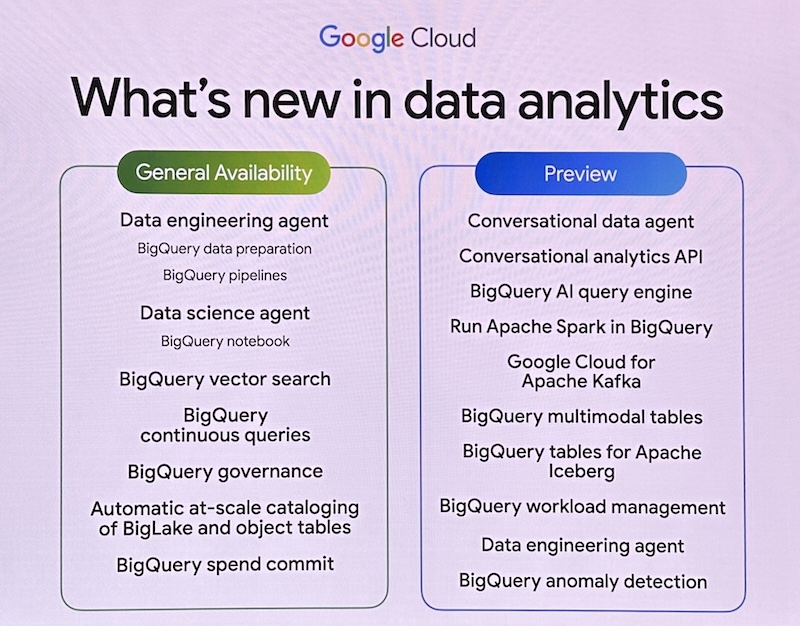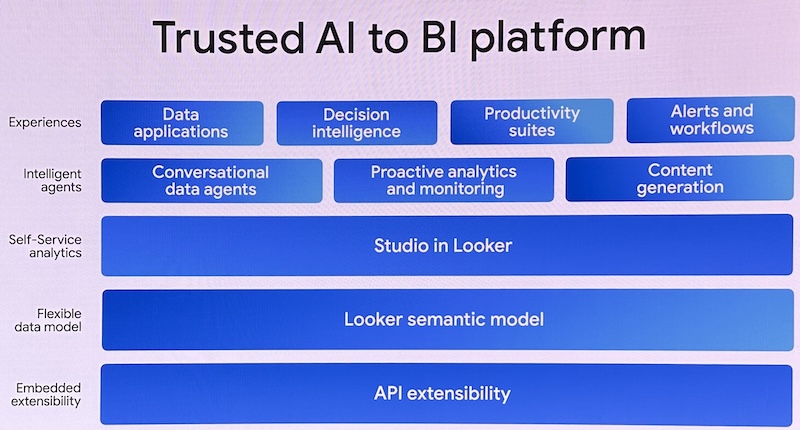Google Cloud makes 229 announcements, but here's what matters for data-to-decision leaders.
Google dropped 229 announcements at Cloud Next 2025, from faster chips, smarter agents, and 500+ customer stories. But beneath the noise, a clear shift emerged: the dissolving of the boundaries between data, analytics, and AI.
What still breaks in the Data-to-Decision flow?
Three problems kept surfacing in exec roundtables and hallway chats:
- Data/AI Silos: BI tools over here, AI tools over there, and governance floating somewhere in between.
- Manual Grind: Too many steps, too many engineers to move data around.
- Insights Are Too Hard and Too Slow to Reach: Business users depend on analysts but can't explore data on their own.
Google's announcements go right at these blockers.
Google's AI-first stack: What's new and why it matters in Data Analytics?

Figure: Google data analytics announcements. Source: Google Cloud Next, April 2025
Open & Unified Data Foundation for Data and AI:
- Multimodal Tables (Preview): Store and analyze structured/unstructured data in one place.
- Open support: Apache Iceberg (Preview), Agent2Agent, and Model Context Protocol (MCP) promote open, interoperable data + AI systems.
- BigQuery Governance Center (GA): Lineage, policy enforcement, anomaly detection across data and models.
- BigQuery Spend Commit (GA): Unified workload budgeting.
Agents for Every Role in the Data Lifecycle
- Data Engineering Agent (GA): Builds and debugs pipelines, generates metadata, and flags anomalies.
- Data Science Agent (GA): Writes code, suggests models, built into notebooks.
- Conversational Data Agent (Preview): Multi-turn natural language queries in Looker.
Smart Querying + Real-Time AI
- BigQuery AI Query Engine (Preview): Combines SQL and Gemini for multimodal, natural language querying.
- BigQuery Continuous Queries (GA): Real-time ingestion, inference, and triggering, removing the need for batch ETL.
- BigQuery Vector Search (GA): Hybrid search across text, embeddings, and structured data.
Composable, Contextual BI with Looker
- LookML Assistant + Spectacles (Preview): Automates modeling, validation, and testing.
- Conversational Analytics (Preview): Turn natural language into charts, summaries, and narratives, and embed that experience into other applications with APIs.
- Embedded Decision Apps (Preview): Build custom workflows and apps using Looker APIs.

Figure: Looker delivers contextual intelligence across touchpoints. Source: Google Cloud Next, April 2025
My POV: A new operating model for Data & AI
- Unified Stacks Are the Future: Modern data platforms converge around core design-first design, blending analytics and AI natively atop unified data foundations.
- Platform Advantage = Governance, Cost, and Integration: With the feature gap between major cloud data platforms narrowing, enterprise buyers prioritize cost efficiency, metadata governance, and ease of AI integration. Google's edge lies in its metadata-first architecture and shared GCP services, with prospects citing lower TCO and AI consolidation as key drivers for their consideration. Microsoft focuses on SaaS simplicity, and AWS leans toward modularity and control.
- Data Agents here: Agent-driven ingestion, prep, profiling, modeling, and orchestration are quickly becoming standard. They are moving from copilots to assistants, to agents, to begin executing on data tasks.
- Semantic = Accuracy and Trust: Google reports a 43% lift in answer accuracy when Looker Semantics are layered on BigQuery. Self-service analytics and AI require data context to be trusted. Google's results highlights that managing semantics and business context isn't a nice-to-have—it's a differentiator.
- Analyst Roles Will Shift: Even as data analysts eagerly tracked new Looker visualization enhancements, leaders should expect fewer data analysts and more data product managers, semantic modelers, and data engineers as analytics gets embedded into business processes.
What Data and AI Leaders Should Do Next
- If you are on GCP: Double down on BigQuery, consider Vertex and Looker to consolidate Google's unified data and AI platform. Customers tout that they benefit from shared consoles and the shared security and governance approach that simplifies operations.
- If you are not on GCP: Compare Google's stack versus components. Review how Google's integration across BigQuery, VertexAI, and Looker resolves siloed AI and BI systems and how it handles structured and unstructured data, real-time data, native ML workflows, and end-to-end governance.
- Empower your data teams with specialized agents: With data management agents becoming more common across platforms, businesses should test ingestion, prep, modeling, and insight agents to reduce the time and skills required to scale data operations.
- Get Serious About the Semantic Layer: Accuracy and trust in analytics and AI depend on knowing the context of the questions made to the data. Investigate your platform or independent tools that simplify creating and maintaining metadata and semantic definitions.
- Stay informed on AI agent evolution: Look beyond copilots. While still early days for multi-agent systems, there's no questioning the level of investment given the potential impact in terms of the next wave of enterprise advantage. Evaluate early support for protocols like MCP and Agent2Agent.
The shift is underway. Platforms like BigQuery and Looker aren't just tools; they're becoming the trust and governance layer for how organizations answer questions, reason, decide, and act. CIOs and CDOs must now re-architect not just the data stack but also the workflows and roles around it to compete in an AI-first enterprise landscape.
Other articles around Google Next
- Constellation Research blog on the overall event
- Customer case studies: Lowe's, Lloyds.
- Google's blog on their 229 announcements.
- Read more on Model Context Protocol (MCP), Agent2Agent (A2A).
What stood out to you most? With so many new capabilities, I only covered the top line. Curious how this stacks up against AWS, Microsoft, or Databricks? Ping me, or drop your thoughts 👇


